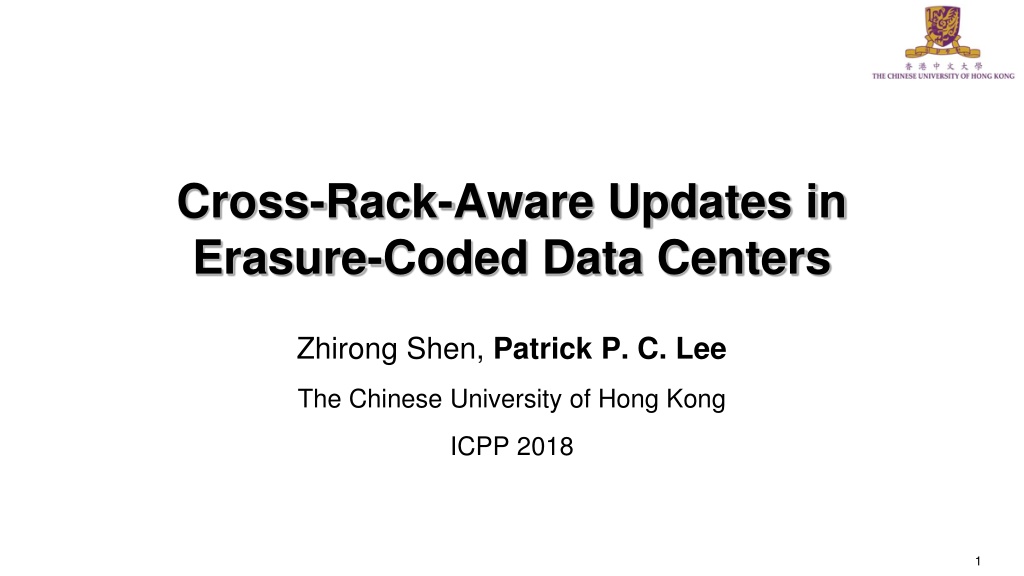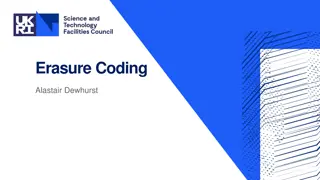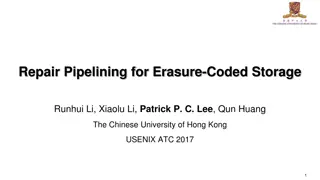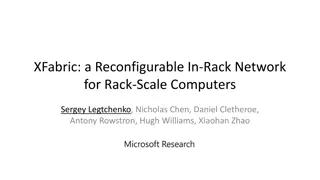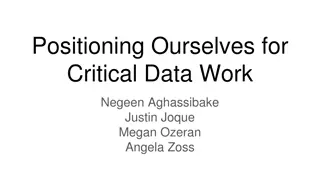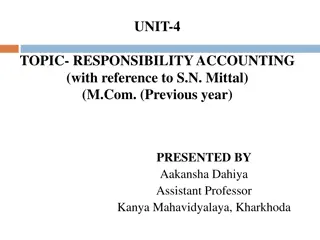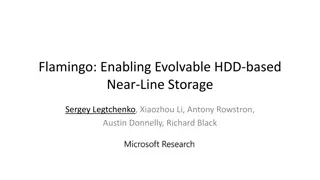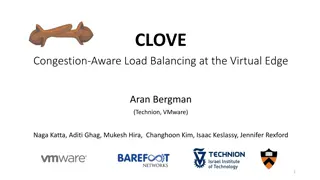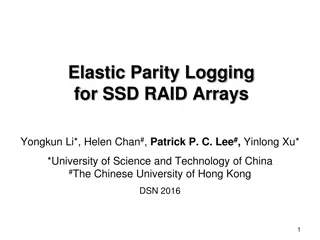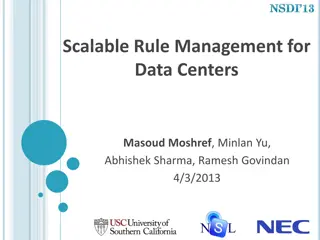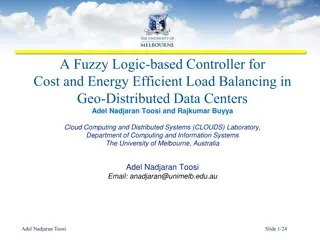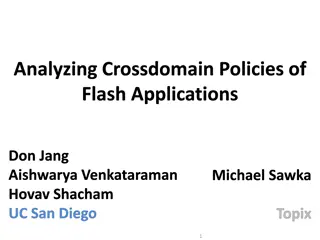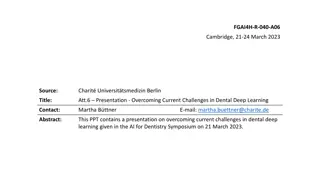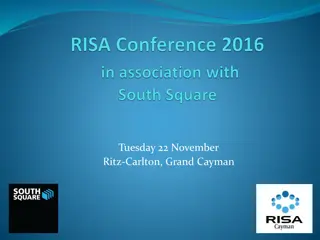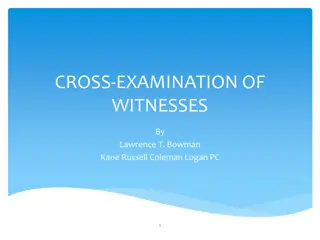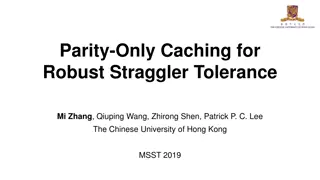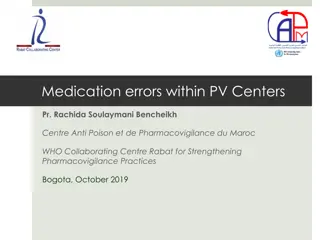Cross-Rack-Aware Updates in Erasure-Coded Data Centers
Erasure coding is a fault-tolerance technique used in modern data centers to minimize data redundancy and increase reliability. This paper explores practical updates in erasure coding, highlighting the challenges of high update penalties and proposing cross-rack-aware strategies to mitigate cross-rack update traffic. By organizing data chunks within fewer racks to reduce cross-rack communication, the approach aims to balance fault tolerance with efficiency in data center operations.
Download Presentation

Please find below an Image/Link to download the presentation.
The content on the website is provided AS IS for your information and personal use only. It may not be sold, licensed, or shared on other websites without obtaining consent from the author. Download presentation by click this link. If you encounter any issues during the download, it is possible that the publisher has removed the file from their server.
E N D
Presentation Transcript
Cross-Rack-Aware Updates in Erasure-Coded Data Centers Zhirong Shen, Patrick P. C. Lee The Chinese University of Hong Kong ICPP 2018 1
Background Properties of modern data centers (DCs) Failures are prevalent Hierarchical topological structure, with nodes organized in racks Cross-rack bandwidth is limited Cross-rack bandwidth is the bottleneck! Network Core Node Rack Rack Rack Hierarchical topology of DC 2
Erasure Coding Erasure coding: a promising technique for fault tolerance Minimum data redundancy via data encoding Higher reliability with same storage redundancy than replication Deployed in Google, Azure, Facebook s data centers e.g., Azure reduces redundancy from 3x (replication) to 1.33x PBs saving Construction of erasure coding: Encode: Generate n-k parity chunks from k data chunks Decode: Any k out of n chunks can recover original file A B A B A B File A+B A+2B Encode Decode (n, k) = (4, 2) 3
Updates in Erasure Coding Practical erasure codes satisfy linearity A parity chunk is a linear combination of k data chunks in Galois Field arithmetic e.g., parity chunk Pj = a1jD1 + a2jD2 + a3jD3 + a4jD4 k = 4, coefficients aij s, and data chunk Di s Delta-based update: If D1 is updated to D1 Pj = a1jD1 + a2jD2 + a3jD3 + a4jD4 = Pj + a1j(D1 - D1) parity delta chunk data delta chunk 4
High Update Penalty Updates are common (e.g., in Yahoo! and Microsoft DCs) Existing DCs store n chunks in n nodes in distinct racks to maximize rack-level fault tolerance Every data chunk update triggers n-k parity chunk updates High cross-rack update traffic data node parity node parity node Rack Rack Rack 5
Motivation Rack failures rarely happen in practice e.g., Only 20 rack failures vs 1000 node failures per year in Google DC Idea: store n chunks in r < n racks Aggregate update traffic within each rack Trade rack-level fault tolerance for less cross-rack update traffic Literature on erasure coding aims for mitigating repair traffic Question: Can we mitigate cross-rack update traffic? 6
Our Contributions Cross-rack-Aware Update (CAU), a general technique to reduce cross-rack update traffic in DCs Selective parity updates Data grouping Interim replication Tolerate a single rack failure Reduce cross-rack update traffic Extensive evaluation: Reliability analysis Trace-driven analysis Experiments on both local cluster and Amazon EC2 Our work applies to geo-distributed data centers 7
Append-Commit Idea: batch updates by deferring parity updates Append: append new updated data chunks into append-only log Commit: update parity chunks in other nodes Trade reliability for performance (to be addressed later) Append to log Update Append Phase Append to log Update Delta Delta Commit Phase Delta Delta Data Node Data Node Parity Node Parity Node 8
Selective Parity Updates Goal: mitigate cross-rack update traffic due to parity updates at nodes in different racks Selective parity updates Based on Patterns of data chunk updates Distributions of parity chunks Two approaches: Data-delta commit Parity-delta commit 9
Data-delta Commit Idea: update multiple parity chunks based on the change of each data chunk If Rack i has i data chunks updated and Rack j stores j parity chunks, send i data delta chunks from Rack i to Rack j D1 Generate new parity chunks: Pi = Pi + a1i D1+ a2i D2 D2 P1 P2 D1 D2 P3 Rack i Rack j i = 2; j = 3 10
Parity-delta Commit Idea: update each parity chunk by aggregating changes of multiple data chunks If Rack i has i data chunks updated and Rack j stores j parity chunks, send j parity delta chunks from Rack i to Rack j a32 D3+ a42 D4+a52 D5 Generate new parity chunks: P1 = P1 + a31 D3 + a41 D4 + a51 D5 D3 D4 P2 P1 a31 D3 + a41 D4 + a51 D5 D5 P2 = P2 + a32 D3+ a42 D4+a52 D5 Rack i Rack j i = 3; j = 2 11
Selective Parity Updates Choose the best in commit phase in each iteration Use data-delta commit when i j Use parity-delta commit when i > j Cross-rack update traffic = min{i , j } Not necessarily theoretically minimum Some data update patterns and erasure codes allow less cross-rack update traffic 12
Data Grouping Relocate updated chunks to save update costs in next commits Several data chunks of a stripe are likely updated again Trade-off: extra swap traffic Activate data grouping only when there is performance gain Details in the paper D5 D2 P3 D1 P1 P2 D3 D4 Rack 3 Rack 4 Rack 5 Rack 1 Rack 2 Swapping D5 with D4 13
Interim Replication How to tolerate loss of updated data chunks before commit? Idea: store one temporary replica in a different rack for each update data chunk Delete the replica after commit No storage overhead in long run 14
Reliability Analysis Approaches: CAU-0: CAU + 0 interim replica CAU-1: CAU + 1 interim replica Erasure coding Results: CAU-0 has highest data loss probability CAU-1 has same order of magnitude of data loss probability with EC e.g., Pcau1= 9.83 10 7, Pec= 2.24 10 7 when ? = 18 Data loss probability vs. append phase duration 15
Prototype Implementation Appended data chunk New data chunk Chunk Metadata Client control flow data flow Metadata Server Replication Ack Node Node Node Node Rack Rack Written in C on Linux Erasure coding is implemented via Jerasure v1.2 Multi-threading to parallelize data transmissions 16
Evaluation Trace-driven analysis Microsoft Cambridge Traces Grouped by update locality (avg # of stripes updated per 1000 updates) Local cluster and Amazon EC2 experiments Compared schemes Baseline: update all n-k parity chunks immediately for each update PARIX[ATC 17]: data logging + parity updates (more traffic, fewer disk I/Os) 17
Trace-driven Analysis Ten traces with high update locality: RS(16,12) with four racks Ten traces with low update locality: RS(16,12) with four racks CAU saves 60.9% and 63.4% of cross-rack update traffic compared to the baseline and PARIX, respectively Higher gains for traces with high update locality 18
Local Cluster Performance Higher performance gain by CAU with more limited cross- rack bandwidth CAU outperforms baseline and PARIX by 41.8% and 51.4%, respectively Update throughput vs. cross-rack bandwidth for RS(9,6) 19
Local Cluster Performance CAU s update throughput first increases with the number of updated stripes in append phase, and stabilizes when the number exceeds 10 Update throughput vs. number of updated stripes in appended phase for RS(9,6) and cross-rack bandwidth = 0.5Gb/s 20
Amazon EC2 Experiments Geo-distributed deployment CAU improves update throughput by up to 33.8% (wdev_3) compared to PARIX Update throughput for (n,k) = (16,12) 21
Conclusions CAU is a novel cross-rack-aware update technique that mitigates cross-rack update traffic for erasure-coded data centers Selective parity updates, data grouping, and interim replication Reliability analysis Prototype implementation of CAU Extensive trace-driven analysis and local cluster and Amazon EC2 experiments Source code: http://adslab.cse.cuhk.edu.hk/software/cau 22
